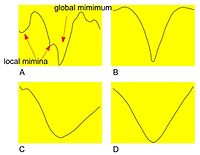Cost functions used in MIPAV algorithms
A similarity or cost function measures the similarity between two images. During the registration the adjusted image V is transformed using the various transformation functions. And the similarity S(U;Vt) between the reference image U and transformed image Vt is then calculated.
Note: in MIPAV, we use the term cost function to refer to the negative cost function. That means that we assume that the transformation that gives the smallest value of the chosen inverse cost function is the transformation that also gives the best alignment.
Background
For the registration algorithms, such as OAR, the main approach for determining an optimal transformation is to
- Calculate a cost function,
- Determine how it changes as individual transformation parameters are varied,
- And find the parameters that minimize the value of the cost function.
The figure below shows a plot of a sample cost function for a selection of transformation parameters.
The cost functions implemented in MIPAV:
Contents
Powell algorithm
In MIPAV, most of the methods and algorithms use the Powell algorithm to find the global minimum of the chosen cost function. For more information about the Powell algorithm, refer to [1].
